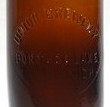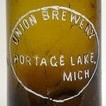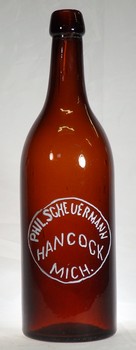11 Aug 2021, last revised 18 Mar 2025
The Union Brewery in Houghton was one of the earliest breweries in the Copper Country. Despite being prominently associated with the name Phil Scheuermann, the brewery was established by William Alt.
From Alt to Scheuermann
William Alt (7) started the brewery in 1857 in the hamlet of Adam two miles west of Houghton (1). William's surname has been spelled as "Ault" (3,7,17), but "Alt" is the correct spelling based on IRS Tax Assessments (19), his death record (12), and Michigan State directories (8,18). In particular, the 1860 directory listed "Alt William" as a brewer and liquor dealer in Houghton (18). A newspaper article suggested that the "Union Brewery" name originated with Alt (23).
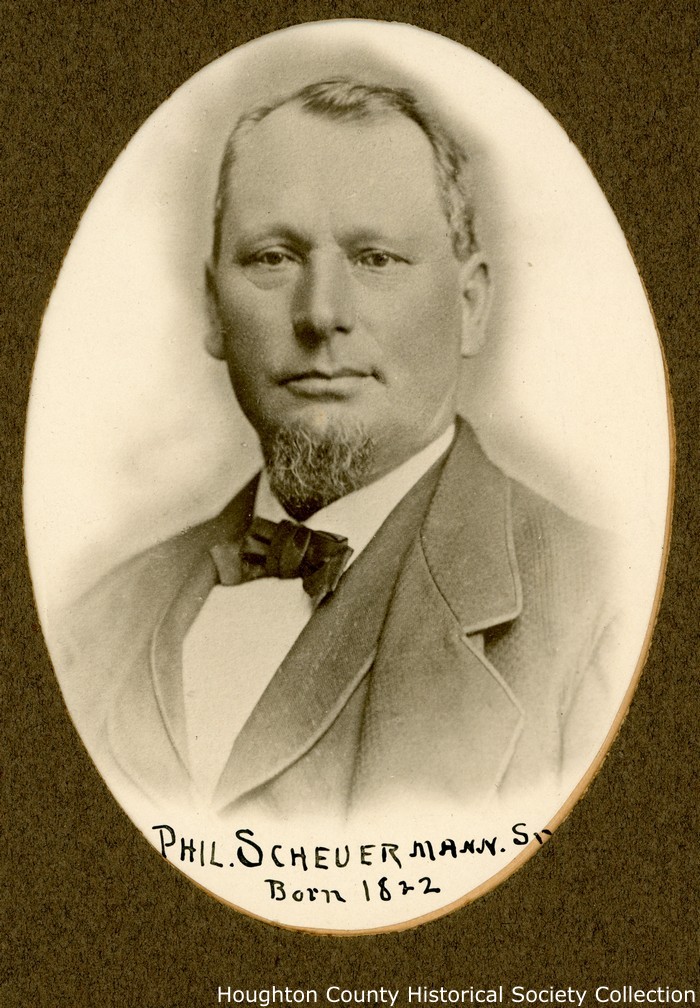
Phil Scheuermann
In 1863, Alt sold the brewery to Philip Scheuermann, Frank Mayworm, and Adam Youngman (7). The IRS Tax Assessment for Aug 1864 indicated that Alt continued as a liquor dealer after selling the brewery (19). His death record stated that he was from Germany and was a saloon keeper when he died on 20 Nov 1872 in Nankin Township, MI at the age of 64 (12).
It was reported that the new owners named their firm "Union Brewing Company" (7), but the 1873 directory specified the firm as "Mayworm, F & Co" for the Union Brewery (9). Mayworm & Co. hosted a gala in Aug 1863 to formally open the brewery to the public (23,25). Tax records for Mayworm & Co. showed that they produced an estimated 1,400 barrels in 1864 and 2,100 barrels in 1865 (19).
Frank's surname has been spelled as "Maywood" (7) or "Mayworth" (17), but "Mayworm" is the correct spelling based on Michigan State directories (6,9,18), the U.S. Federal Census (10,20), the newspaper (23), and IRS Tax Assessments (19). Mayworm died on 07 Oct 1872 at the age of 47 from typhoid fever (12). In 1875 (1,5,21,24), Scheuermann purchased the interests of Mayworm's widow and Youngman; thus, becoming sole owner (7).
Philip Scheuermann was born in Bavaria, Germany on 16 Sep 1822 (16). He apprenticed in the carpentry and mill-wright trade and worked as a journeyman (1). In 1850, he immigrated to Copper Falls where he built the mill for the Copper Falls Mining Company and remained for about five years (1). He then went to Missouri where he built and operated a saw mill for five years (1). He returned to the Copper Country in 1859 and built the Quincy Stamp Mill on Portage Lake near Hancock in 1860 and became its superintendent (1).
Growth and Expansion
In 1875, Scheuermann rebuilt the brewery, which increased production to 5,000 barrels per year (1). Production in 1877 was 4,231 barrels (28). Scheuermann began bottling his beer around 1879-80, as indicated by the bottles, as did many brewers across the country following the advent of pasteurization. He continued to use the Union Brewery name as indicated by newspaper ads and the bottles.

Polk Directory ad - 1883
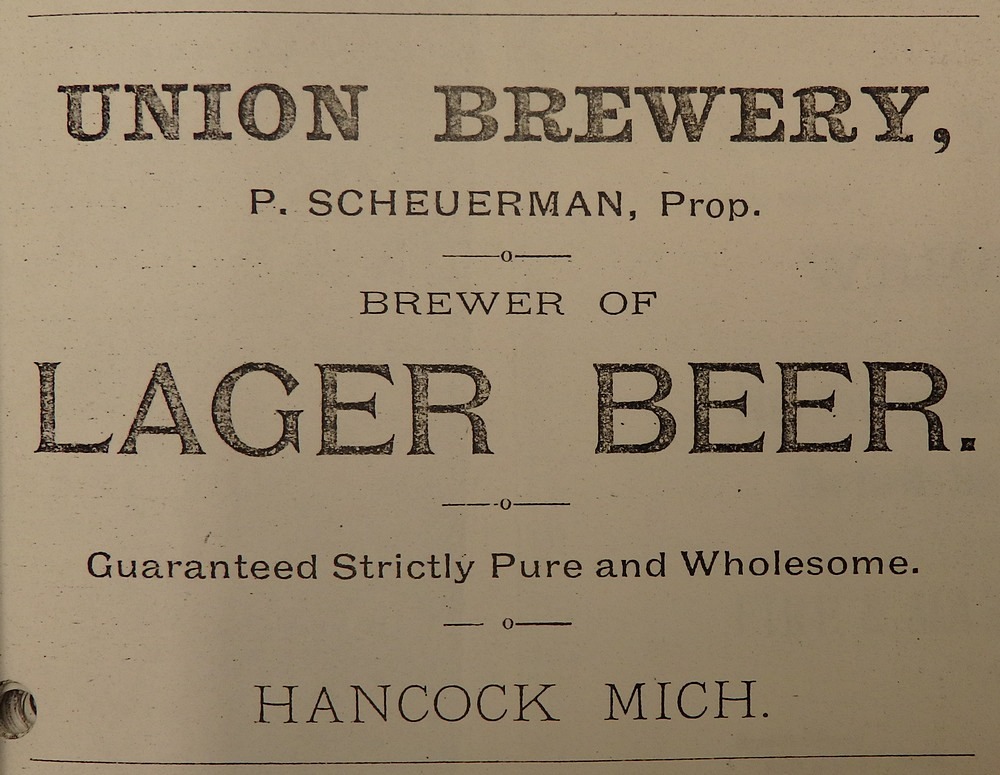
Holland Directory ad - 1887
In Jan 1888, the brewery received five enormous beer casks, no less than five feet in length, from Milwaukee (30). In 1890, the brewery replaced its vats with new vats having a total capacity of 1,000 barrels, which increased the brewery's capacity to 10,000 barrels (29).
Incorporation and Name Change
The business was incorporated on 01 Jan 1895 with Phil Scheuermann as president, his daughter, Anna as vice-president, and his son, Philip Jr. as secretary and treasurer (7). The capital of $50,000 was divided into 5,000 shares at $10 each (31). Upon incorporation, the company declared that the Union Brewery would thereafter do business as the "Phil. Scheuermann Brewing Co." (31). We see this name change reflected on the bottles. However, a Jun 1893 ad cited the name, "Phil. Scheuermann Brewing Co." and newspapers continued to refer to the brewery as the "Union Brewery" (e.g., 11,32,33,37).

Newspaper ad - Jun 1893
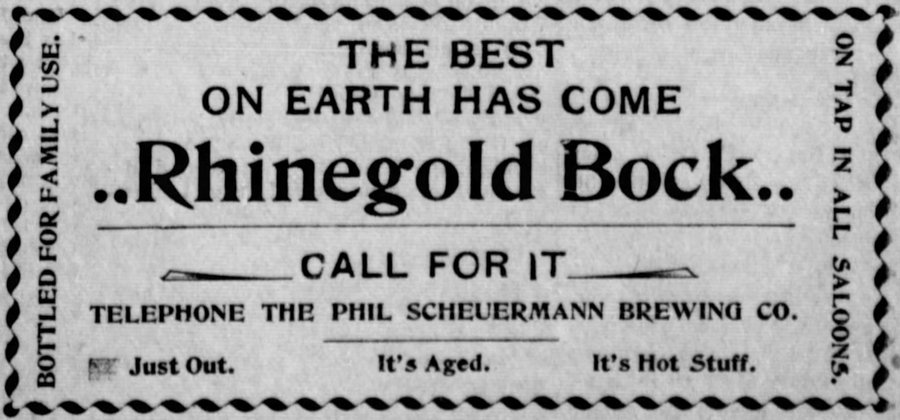
Newspaper ad - May 1898
Confusion with Brewery Location
The location embossed on the bottles changed from PORTAGE LAKE to HANCOCK to HOUGHTON COUNTY to HOUGHTON, and then to HANCOCK. The reasoning behind this succession of locations is intriguing, especially when the brewery was clearly located in Houghton. "Portage Lake" was not a town name, but the 1863 directory used "Portage Lake district" to describe the location of the mines in the Houghton/Hancock area (6). Even in the late 1890s, The Copper Country Evening News used "Portage Lake" to refer to the towns of Houghton and Hancock. The 1887 Holland directory listed Phil Scheuermann in the Hancock (not Houghton) directory and noted that the Union Brewery office was located at the Quincy Mill where Phil Scheuermann was superintendent (5). Scheuermann was also a resident of Hancock (5). Thus, the use of Hancock as the location on the bottles seem to have been based on the office location.

Scheuermann brewery

Scheuermann bottling house
Renovations
The buildings for the brewery were incrementally rebuilt and expanded. The 1888 Sanborn map showed only wooden frame structures. The 1893 map showed one stone building attached to the bottling house. It was reported in May 1898 that the company built a new framed bottling house on the lake shore equipped with a refrigerator (22). The 1900 map showed this bottling house, as well as a stone front and stone addition to the brewery.

Sanborn map - June 1888

Sanborn map - Aug 1893
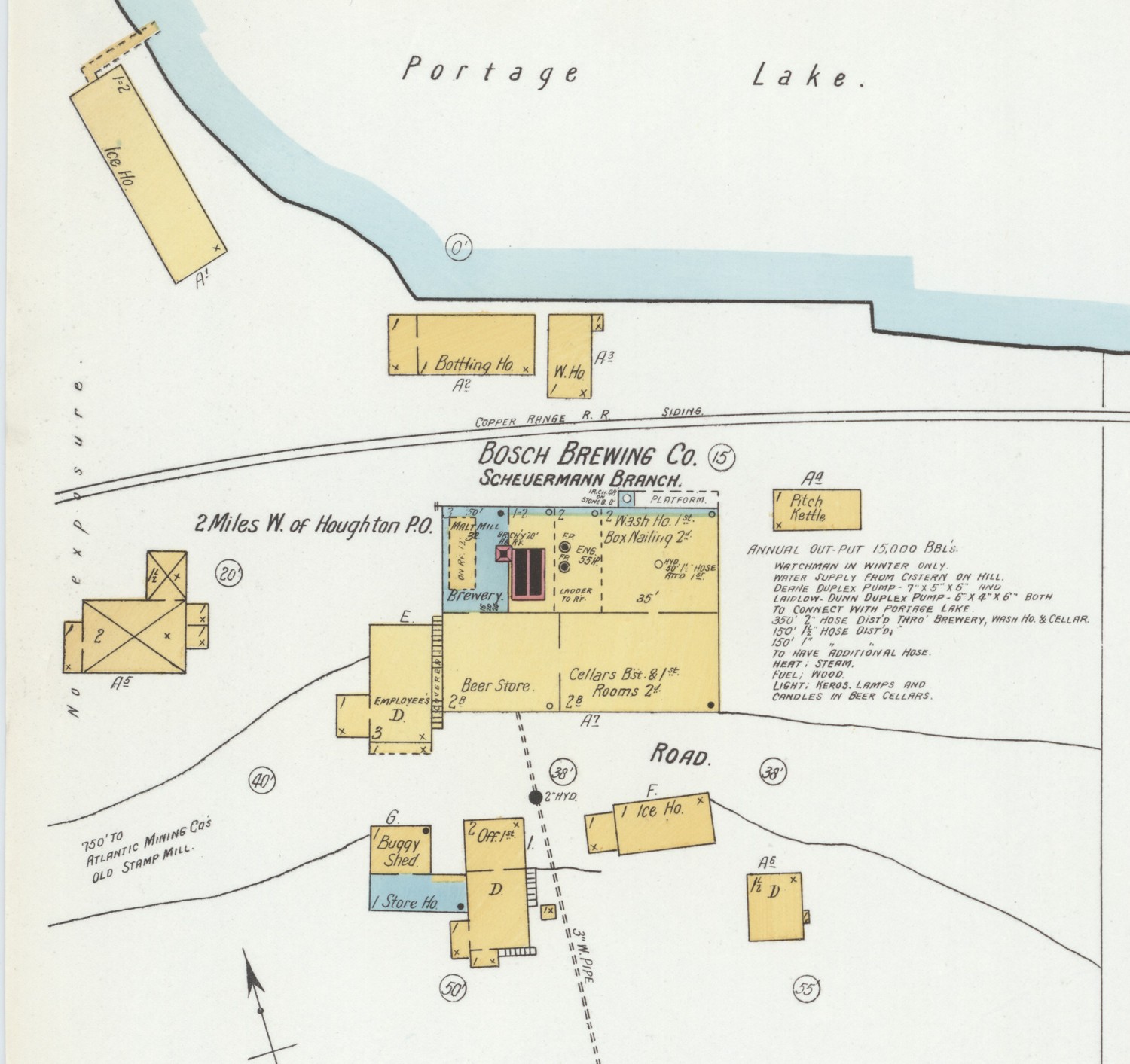
Sanborn map - June 1900
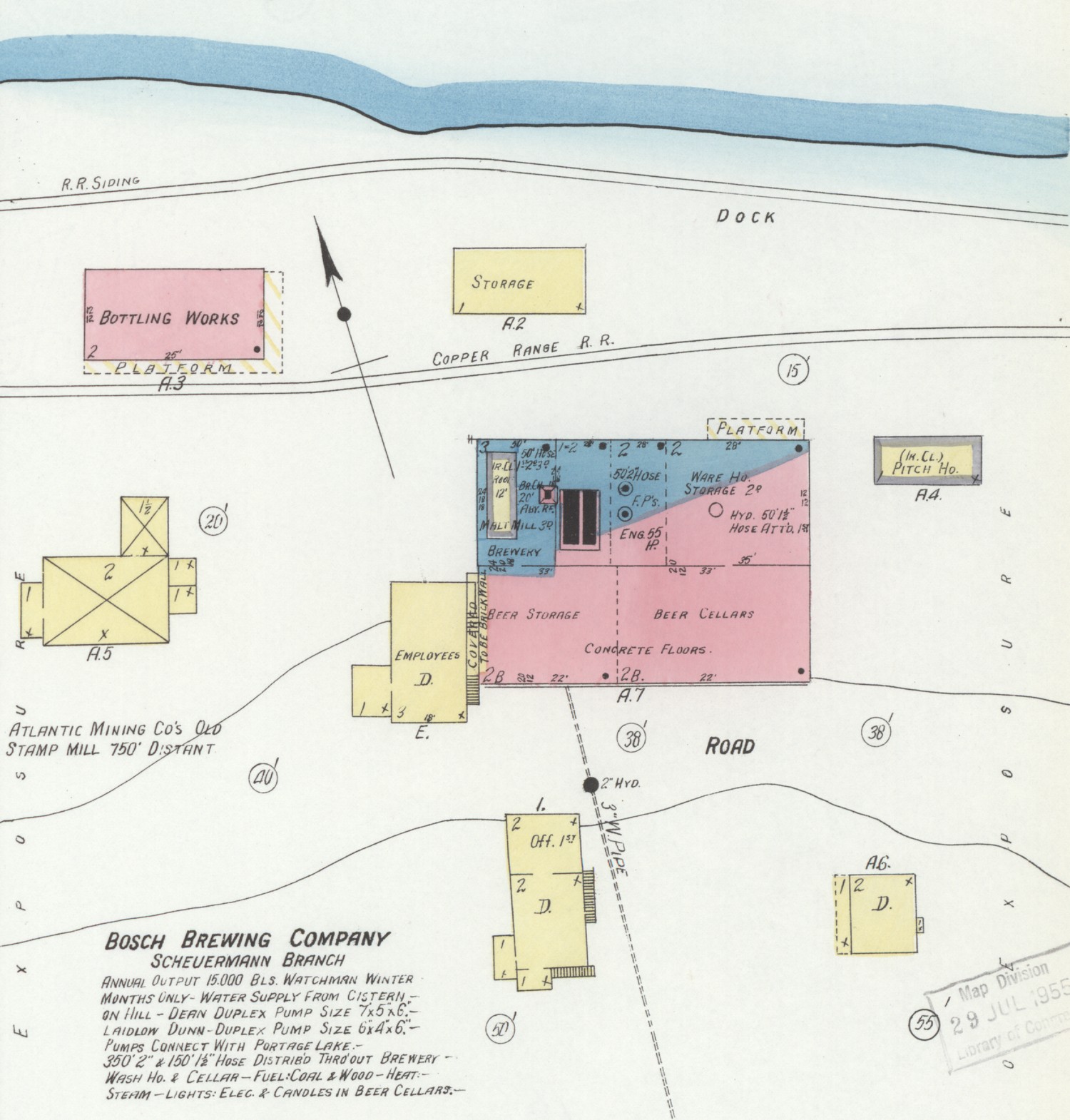
Sanborn map - Feb 1908
Change in Ownership
Philip Scheuermann died on 30 Mar 1898 at the age of 75 and was buried in Forest Hill Cemetery, Houghton (16). Frank Scheuermann, Philip's son from his second marriage (1), then managed the brewery and continued to make improvements (33).
In Jan 1899, the company was taken over by the Bosch Brewing Co., but Frank still retained his interest and remained as manager (3). Bosch continued to operate the brewery as the Scheuermann Branch of the Bosch Brewing Co. (2). Despite the change in ownership, the Scheuermann name remained, but it changed from PHIL. SCHEUERMANN BREWING CO. to PHIL. SCHEUERMANN BREWERY on the bottles and ads, or simply SCHEUERMANN BREWERY on later ads. The Polk directories also marked this name change, being "Phil. Scheuermann Brewing Co." in 1897 (13), not listed in 1899 (14), and "Scheuermann Brewery" in 1901 (15). This name change makes sense, since it was no longer the Phil. Scheuermann Brewing Co. (it was the Bosch Brewing Co.), but the facility was still known as the Scheuermann brewery.
More Renovations
In Jun 1899, work commenced to improve the Scheuermann plant, which Bosch contemplated when he acquired control (34). When finished, it was expected that the plant would be almost entirely new. A new main building would enclose the present main building, and be divided into a racking room, washhouse, machine room, boiler room, and brewhouse. New machinery would be installed piece by piece so not to interrupt current operations. It was estimated that the plant would be able to produce 50,000 barrels annually.
In May 1904, a new 70x30 ft brick, two-story bottling house with a basement was completed (38). The basement stored new bottles, while the first floor contained the washing, labeling, filling, and corking machines (38). The bottles were cleaned by tumbling them for 20 minutes in a "hot solution of soda" and then rinsing them in a tank of cold water, 16 bottles at a time (38). The bottles were then labeled, filled, and corked at a rate of 60 - 80 barrels in ten hours (38). Cases for the bottles were constructed in the upper floor (38). The old framed bottling works would be moved and used for storage (38). The 1908 Sanborn map and photograph above show this new bottling house. In Jan 1908, extensive improvements were completed, which included a new refrigerator plant (36). The renovation totaled $18,000, which "practically represent the rebuilding of the entire brewery" (36).
The brewery had 12 employees in 1904 (26) and a peak of 25 in 1909 (27).
Beer Brands and Styles
Newspaper ads indicate that Reingold was the brewery's signature brand. On or after 01 Aug 1900, the brewery released Royal Brew, which was sold "only in white bottles" (recognized as aqua today) since it was so good it could not be sold in bulk (35). The brewery also marketed seasonal beers such as a special brew for New Year's Day (42) and bock beer in spring (43).

Newspaper ad - Mar 1899
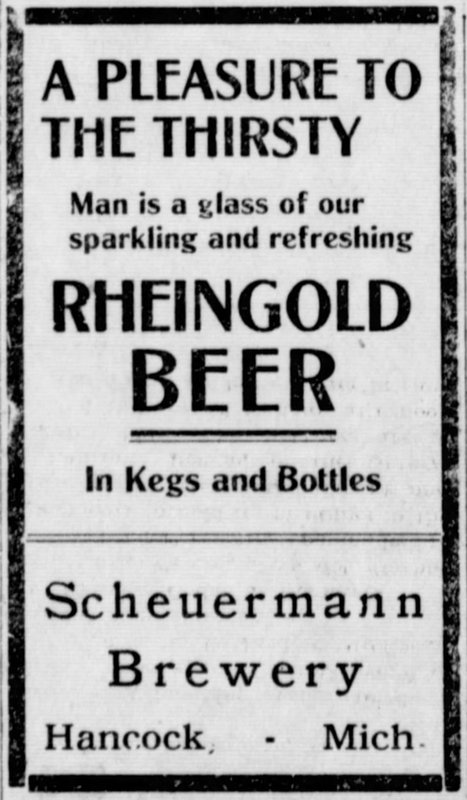
Newspaper ad - Dec 1909

Newspaper ad - Aug 1912
Prohibition Ends the Scheuermann Name
When state prohibition commenced on 01 May 1918 (38), operations ceased. After national and state prohibition were amended to legalize beer and wine of 3.2% alcohol (39,40), the Bosch Brewing Co. resumed operations at the Scheuermann brewery (41). The Scheuermann name passed into brewing history, but the bottles continue to provide collectors with wonderful old artifacts from the pioneer era of the Copper Country.

Rheingold label

Bock label
Citations
- anonymous. 1883. History of the Upper Peninsula of Michigan. The Western Historical Company. Chicago, IL.
- anonymous. 1903. Biographical Record: Houghton, Baraga and Marquette Counties, Michigan. Biographical Publishing Company. Chicago, IL.
- anonymous. (1899, Jan 26). Portage Lake news. The Copper Country Evening News (Calumet, MI). p. 3.
- Monette, C. J. 1978. Joseph Bosch and the Bosch Brewing Company. Welden H. Curtin. Lake Linden, MI.
- Holland, A. H. 1887. Hand-book and Guide to Hancock, Mich. Mining Journal Book and Job Print. Marquette, MI.
- C. F. Clark. 1863. Michigan State Gazetteer and Business Directory for 1863-4. Charles F. Clark. Detroit, MI.
- anonymous. 1895. Memorial Record of the Northern Peninsula of Michigan. The Lewis Publishing Co., Chicago, IL.
- G. W. Hawes. 1859. Michigan State Gazetteer and Business Directory for 1860. F. Raymond & Co. Detroit, MI.
- J. E. Scripps and R. L. Polk & Co. 1873. Michigan State Gazetteer and Business Directory for 1873. Tribune Book and Job Office. Detroit, MI.
- U.S. Census Bureau. 1870 United States Federal Census. accessed on ancestry.com.
- anonymous. (1904, May 27). Bottling plant. Hancock Evening Journal (Hancock, MI). p. 8.
- Michigan Department of Community Health, Division for Vital Records and Health Statistics; Lansing, Michigan; Death Records (accessed on ancestry.com).
- R. L. Polk & Co. 1897. Houghton County Directory 1897-98. R. L. Polk & Co., Publishers. Detroit, MI.
- R. L. Polk & Co. 1899. Houghton County Directory 1899-1900. R. L. Polk & Co., Publishers. Detroit, MI.
- R. L. Polk & Co. 1901. Houghton County Directory 1901-02. R. L. Polk & Co., Publishers. Detroit, MI.
- Find a Grave. accessed Aug 2021. Philip Scheuermann. findagrave.com/memorial/182276421/philip-scheuermann
- Van Wieren, D. P. 1995. American Breweries II. Eastern Coast Brewiana Association. West Point, PA.
- G. W. Hawes. 1860. Michigan State Gazetteer and Business Directory for 1860. F. Raymond & Co. Detroit, MI.
- Records of the Internal Revenue Service. Internal Revenue Assessment Lists for Michigan, 1862-1866. The National Archives at Washington, DC (accessed on ancestry.com).
- U.S. Census Bureau. 1860 United States Federal Census. accessed on ancestry.com.
- anonymous. 1903. One Hundred Years of Brewing. H. S. Rich & Co., Publishers. Chicago and New York.
- anonymous. (1898, May 02). Portage lake news. The Copper Country Evening News (Calumet, MI). p. 3.
- anonymous. (1863, Aug 15). The Union Brewery. The Mining Gazette (Houghton, MI). p. 5.
- anonymous. (1875, Jul 29). Notice. Portage Lake Mining Gazette (Houghton, MI). p. 3.
- anonymous. (1863, Aug 08). Gala day for beer. The Mining Gazette (Houghton, MI). p. 5.
- Bureau of Labor and Industrial Statistics. 1905. State of Michigan Twenty-Second Annual Report of the Bureau of Labor and Industrial Statistics Including the Twelfth Annual Report of State Inspection of Factories. Wynkoop Hallenbeck Crawford Co., State Printers. Lansing, MI.
- State of Michigan Department of Labor. 1910. First Annual Report of the Department of Labor of the State of Michigan. Wynkoop Hallenbeck Crawford Co., State Printers. Lansing, MI.
- anonymous. (1879, Jul 24). Amount of lager beer made and sold in this district last year. Portage Lake Mining Gazette (Houghton, MI). p. 3.
- anonymous. (1890, May 29). About Portage Lake. Portage Lake Mining Gazette (Houghton, MI). p. 4.
- anonymous. (1888, Jan 12). Local jottings. Portage Lake Mining Gazette (Houghton, MI). p. 3.
- anonymous. (1895, Jan 08). untitled. The Native Copper Times (Lake Linden, MI). p. 3.
- anonymous. (1898, Dec 15). Improvements being made at the Union Brewery. The Copper Country Evening News (Calumet, MI). p. 3.
- anonymous. (1899, Mar 02). Torch Lake news. The Copper Country Evening News (Calumet, MI). p. 4.
- anonymous. (1899, Jun 05). Portage Lake news. The Copper Country Evening News (Calumet, MI). p. 3.
- anonymous. (1900, Aug 01). A new candidate. The Copper Country Evening News (Calumet, MI). p. 3.
- anonymous. (1908, Jan 29). Extensive improvements. The Calumet News (Calumet, MI). p. 4.
- anonymous. (1909, Sep 17). Brewery team runs away. The Calumet News (Calumet, MI). p. 3.
- anonymous. (1919, Feb 14). National and state prohibition. The L'Anse Sentinel (L'Anse, MI). p. 8.
- anonymous. (1933, Mar 23). Provisions of U.S. beer bill. The Daily Mining Gazette (Houghton, MI). p. 5.
- anonymous. (1933, Apr 28). Cameras record end of 15 years of prohibition. The Daily Mining Gazette (Houghton, MI). p. 1.
- anonymous. (1933, May 14). Bosch beer, made in Copper Country, to be ready July 1. The Daily Mining Gazette (Houghton, MI). p. 12.
- anonymous. (1903, Jan 02). New Year's brew. Hancock Evening Journal (Hancock, MI). p. 4.
- anonymous. (1905, Apr 21). Houghton brevities. The Daily Mining Gazette (Houghton, MI). p. 2.
color: amber or dark amber
top: lightning stopper - applied
base: post-bottom
maker's mark: C & Co (base)
other marks: (none)
date: 1878-1880
rarity: extremely rare
- full-mold plate
color: amber
top: lightning stopper - applied
base: post-bottom
maker's mark: C. V. No2 MILW (base)
other marks: (none)
date: 1880-1881
rarity: extremely rare
- same plate for 32, 32a, and 32b
- same plate for 32, 32a, and 32b
- tapered-top variant
maker's mark: (none)
other marks: (none)
rarity: extremely rare
- same plate for 32, 32a, and 32b
- tapered-top variant
- color variant
- no maker's mark
color: amber
top: lightning stopper - applied
base: post-bottom
maker's mark: WIS GLASS Co MILW (front heel)
other marks: (none)
date: 1881-1886
rarity: extremely rare
- different plate from 32
- MICH centered
color: amber
top: lightning stopper - applied
base: post-bottom
maker's mark: D. O. C. (base)
other marks: (none)
date: mid- to late 1880s
rarity: rare
- different plate design
- smaller plate than 34
- smaller font for ICH in MICH
color: amber
top: Baltimore loop seal - applied
base: post-bottom
maker's mark: D. O. C. (base)
other marks: THIS BOTTLE NOT TO BE SOLD (back)
date: late 1880s
rarity: rare
- different plate from 35
- larger font
- "." after BREWERY
- same-sized letters in MICH
- smaller plate
color: amber
top: Baltimore loop seal - applied
base: post-bottom
maker's mark: D. O. C. (back heel)
other marks: (none)
date: late 1880s
rarity: rare
- pint-sized complement to 37
color: amber
top: Baltimore loop seal - applied
base: post-bottom
maker's mark: D. O. C. (base)
other marks: THIS BOTTLE NOT TO BE SOLD (back)
date: late 1880s
rarity: extremely rare
- different plate from 37
- exceptionally large plate
- plate low on mold
color: amber
top: lightning stopper - applied
base: post-bottom
maker's mark: (none)
other marks: THIS BOTTLE NOT TO BE SOLD (back)
date: late 1880s - early 1890s
rarity: extremely rare
- different plate design
- only Scheuermann with a lightning-stoppered top
color: amber
top: Baltimore loop seal - applied
base: post-bottom
maker's mark: (none)
other marks: NOT TO BE SOLD OR TRADED (back)
date: early 1890s
rarity: rare
- different plate design
- exceptionally large plate
- plate low on mold
color: amber
top: Baltimore loop seal - applied
base: post-bottom
maker's mark: (none)
other marks: (none)
date: early 1890s
rarity: rare
- different plate design
- typical-sized plate
color: amber
top: Baltimore loop seal - tooled
base: post-bottom
maker's mark: (none)
other marks: (none)
date: mid-1890s
rarity: rare
- different plate design
- same plate for 41 and s33
color: amber
top: Baltimore loop seal - tooled
base: post-bottom
maker's mark: (none)
other marks: (none)
date: mid-1890s
rarity: extremely rare
- same plate for #41 and #s33
- slightly taller body
- plate higher on mold (see comparison)
color: amber
top: Baltimore loop seal - tooled
base: cup-bottom
maker's mark: WIS G Co. MILW (base)
other marks: (none)
date: mid-1890s
rarity: rare
- pint-sized complement to 41
- The base shows mold deterioration, suggesting that Cream City Glass Co. continued to use the post-bottom from Wisconin Glass Co.
color: amber
top: Baltimore loop seal - applied
base: post-bottom
maker's mark: D. O. C. (back heel)
other marks: (none)
date: 1895-c.1897
rarity: scarce
- different plate design
- slightly curved HANCOCK
- no "." after CO
maker's mark: N. B. B. G. CO. (back heel)
other marks: (none)
date: 1895 - late 1890s
rarity: rare
- different plate from 44
- "." after CO
- narrower gap between PHIL and SCHEUERMANN
maker's mark: S B & G Co (base)
other marks: THIS BOTTLE NOT TO BE SOLD (back)
date: 1895 - late 1890s
rarity: rare
- different plate from 44 and 44a
- smaller plate size
- no "." after CO or PHIL
- H in HANCOCK not tilted
- This variant was pictured in the book.
color: amber
top: Baltimore loop seal - tooled
base: post-bottom
maker's mark: (none)
other marks: THIS BOTTLE IS NEVER SOLD (back heel)
date: 1895 - late 1890s
rarity: rare
- different plate from 44, 44a, and 44b
- reversed N in BREWING
- H in HANCOCK only slightly left of R in BREWING
color: amber
top: Baltimore loop seal - tooled
base: post-bottom
maker's mark: (none)
other marks: (none)
date: late 1890s
rarity: scarce
- different plate design
color: amber
top: Baltimore loop seal - tooled
base: post-bottom
maker's mark: (none)
other marks: THIS BOTTLE IS NEVER SOLD (back)
date: late 1890s
rarity: extremely rare
- pint-sized complement to 47
color: amber
top: Baltimore loop seal - tooled
base: post-bottom
maker's mark: CLYDE GLASS WORKS CLYDE N.Y. (base)
other marks: (none)
date: late 1890s
rarity: rare
- different plate from 47
- SCHEUERMANN misspelled
- "." after CO is elevated
- "." after HANCOCK
color: amber
top: Baltimore loop seal - tooled
base: post-bottom
maker's mark: (none)
other marks: THIS BOTTLE NOT TO BE SOLD (base)
date: 1900-c.1903
rarity: common
- different plate design
other marks: THIS BOTTLE NOT TO BE SOLD (base)
rarity: common
- different plate from 49
- MICH right of center
color: amber
top: Baltimore loop seal - tooled
base: cup-bottom
maker's mark: (none)
other marks: THIS BOTTLE NOT TO BE SOLD (base)
date: 1900-c.1903
rarity: rare
- pint-sized complement to 49
- same plate for 50 and 52
color: amber
top: Baltimore loop seal - tooled
base: post-bottom
maker's mark: (none)
other marks: REGISTERED (below plate), THIS BOTTLE NOT TO BE SOLD (base)
date: c.1905
rarity: common
- different plate from 49
- HANCOCK has a boarder span
- "." after MICH was not painted in book
other marks: REGISTERED (below plate), THIS BOTTLE NOT TO BE SOLD (base)
date: early 1900s
rarity: extremely rare?
- different plate from 51
- smaller font with greater spacing between lines
- no "." after PHIL
color: amber
top: Baltimore loop seal - tooled
base: post-bottom
maker's mark: (none)
other marks: REGISTERED (below plate), THIS BOTTLE NOT TO BE SOLD (base)
dated: 1907, 1908
rarity: common
- pint-sized complement to 51
- same plate for 50 and 52
- P in PHIL directly left of BREWERY
- back heel has A B Co date code 7 - S
- another example has date code 8 - S
color: amber
top: Baltimore loop seal - tooled
base: post-bottom
maker's mark: S B & G Co (base)
other marks: (none)
date: c.1903-1905
rarity: rare
- export-shaped mold
- different plate design
- appears to be the same plate as 53 but with "." after MICH
- different maker's mark
- back heel has date code 9 - S
color: amber
top: Balitmore loop seal - tooled
base: post-bottom
maker's mark: A B Co (back heel)
other marks: THIS BOTTLE NOT TO BE SOLD (base)
dated: 1908
rarity: common
- full-mold plate
- back heel has date code 8 - S
- R in BREWERY right of E in SCHEUERMANN
- Other specimens have date codes: 0 - S (for 1910) and 9 - S.
color: aqua
top: cork seal
base: ?
maker's mark: A B Co. (base?)
other marks: (none)
date: 1905-1910
rarity: rare
- full-mold plate
- same plate for 55, 56, and s3
- held Royal Brew
color: aqua
top: Baltimore loop seal - tooled
base: post-bottom
maker's mark: A B Co (base)
other marks: (none)
dated: 1909
rarity: rare
- same plate for 55, 56, and s3
- different top
- back heel has date code 9 - S
- held Royal Brew
color: aqua
top: crown top - tooled
base: post-bottom
maker's mark: A B Co (base)
other marks: (none)
date: c.1910
rarity: extremely rare
- same plate for 55, 56, and s3
- different top
- The date code appears to be 4 - S but A B CO did not exist in 1904.
- held Royal Brew
color: aqua
top: Baltimore loop seal - tooled
base: post-bottom
maker's mark: A B Co (base)
other marks: (none)
dated: 1911
rarity: rare
- circle plate
- back heel has date code 11 - S
- held Royal Brew
color: amber
top: crown top - tooled
base: post-bottom
maker's mark: (none)
other marks: THIS BOTTLE NOT TO BE SOLD (base)
dated: 1912
rarity: scarce
- different plate from 54
- R in BREWERY under E in SCHEUERMANN
- The book stated a maker's mark of N B B G Co.
- back heel has A B Co date code S - 12
color: amber
top: crown top - tooled
base: post-bottom
maker's mark: (none)
other marks: REGISTERED (below plate), THIS BOTTLE NOT TO BE SOLD (base)
date: 1912
rarity: common
- different plate from 52
- P in PHIL below BREWERY
color: amber
top: crown top - tooled
base: post-bottom
maker's mark: N B B G CO (front heel)
other marks: THIS BOTTLE NOT TO BE SOLD (base)
date: c.1915
rarity: extremely rare
- shoulder embossing
color: amber
top: crown top - ABM
base: post-bottom
maker's mark: (none)
other marks: THIS BOTTLE NOT TO BE SOLD (base)
dated: 1914
rarity: common
- Heel has "14 2", which appears to be a date code.
color: amber
top: crown top - ABM
base: post-bottom
maker's mark: (none)
other marks: THIS BOTTLE NOT TO BE SOLD (base)
dated: 1917
rarity: common
- shoulder embossing
- back heel has A B Co. date code 17 S 4
color: amber
top: crown top - ABM
base: post-bottom
maker's mark: (none)
other marks: THIS BOTTLE NOT TO BE SOLD (base)
dated: 1918
rarity: common
- back heel has A B Co. date code 18 S 2
other marks: THIS BOTTLE NOT TO BE SOLD (base)
dated: 1917
rarity: common
- different plate from abm-12
- back heel has A B Co. date code 17 S 1
color: amber
top: crown top - ABM
base: post-bottom
maker's mark: (none)
other marks: (none)
dated: 1916
rarity: rare
- export-shaped mold
- back heel has A B Co. date code 16 S 1
color: amber
top: crown top - ABM
base: post-bottom
maker's mark: (none)
other marks: (none)
dated: 1916
rarity: rare
- pint-sized complement of abm-13
- back heel has A B Co. date code 16 S 1
color: aqua
top: crown top - ABM
base: cup-bottom
maker's mark: (none)
other marks: (none)
dated: 1915
rarity: scarce
- Heel has "15 1", which appears to be a date code.
- held Royal Brew
color: aqua
top: crown top - ABM
base: post-bottom
maker's mark: (none)
other marks: THIS BOTTLE NOT TO BE SOLD (base)
dated: 1916
rarity: scarce
- pint-sized complement of abm-15
- back heel has A B Co. date code 16 S 1
- held Royal Brew
color: amber
top: crown top - ABM
base: post-bottom
maker's mark: (none)
other marks: THIS BOTTLE NOT TO BE SOLD (base)
dated: 1914
rarity: scarce
- Heel has "14 1", which appears to be a date code.
color: aqua
top: crown top - ABM
base: post-bottom
maker's mark: (none)
other marks: THIS BOTTLE NOT TO BE SOLD (base)
dated: 1913
rarity: rare
- Heel has "13 1", which appears to be a date code.
- held Royal Brew




